Strategic Management Report: Business Environment & Strategies
VerifiedAdded on 2021/02/20
|16
|4731
|46
Report
AI Summary
This report provides a comprehensive strategic management analysis of The Warehouse New Zealand. It begins with an introduction to business organizations and their need for strategic planning in a dynamic environment. The report then delves into the business environment analysis, employing PESTEL, value chain, SWOT, and Porter's Five Forces models to assess the external and internal factors impacting the company. The PESTEL analysis examines political, economic, social, technological, environmental, and legal factors, while the value chain analysis dissects primary and support activities. SWOT analysis identifies strengths, weaknesses, opportunities, and threats, and Porter's Five Forces model evaluates competitive dynamics. The report further explores strategies at functional, business, and corporate levels, evaluating their effectiveness and offering recommendations for senior management. Finally, the report addresses the impact of technology and globalization on business operations. The analysis aims to provide insights for making a strong base in the market. The Warehouse is a retail firm that offers grocery and non-grocery products.
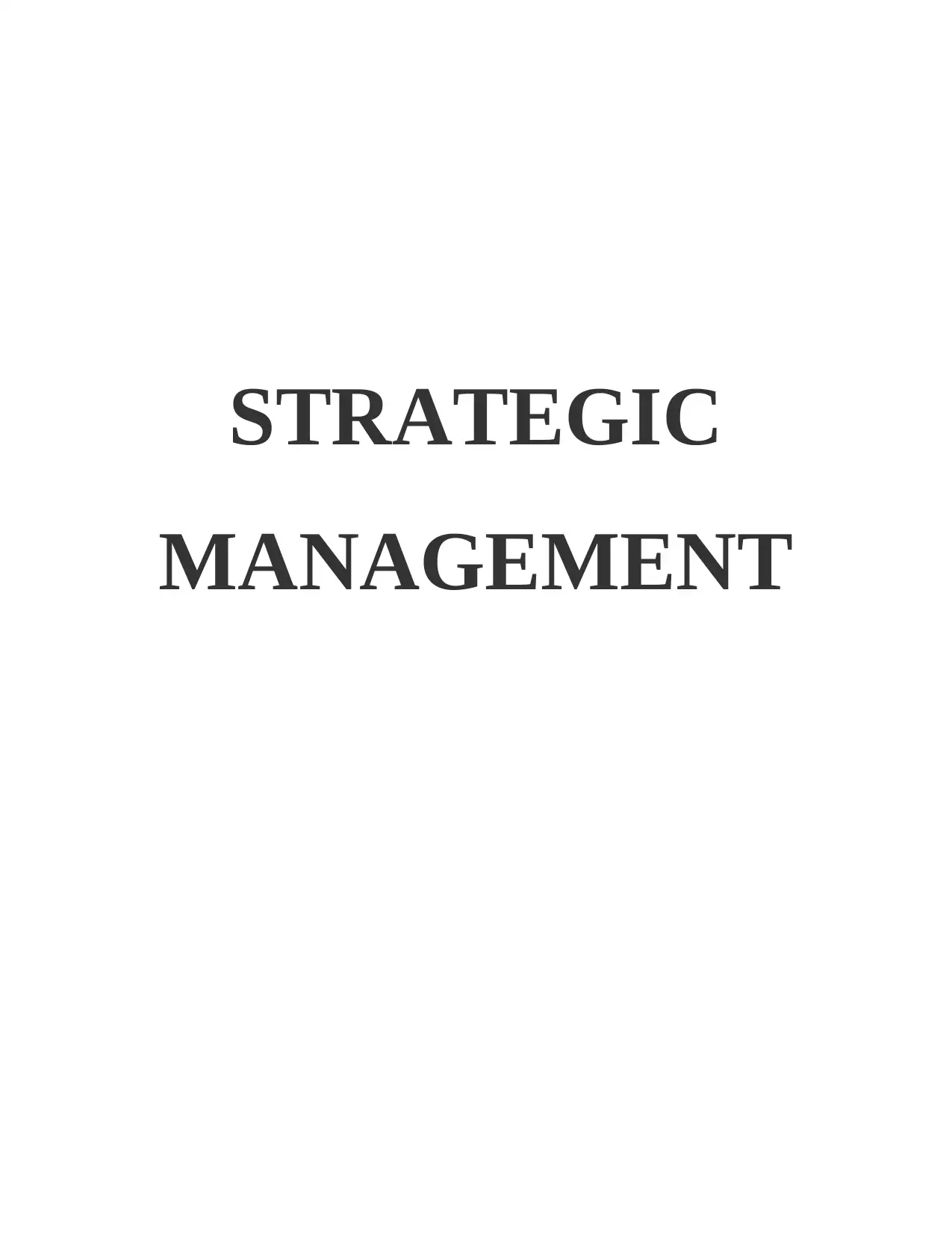
STRATEGIC
MANAGEMENT
MANAGEMENT
Paraphrase This Document
Need a fresh take? Get an instant paraphrase of this document with our AI Paraphraser
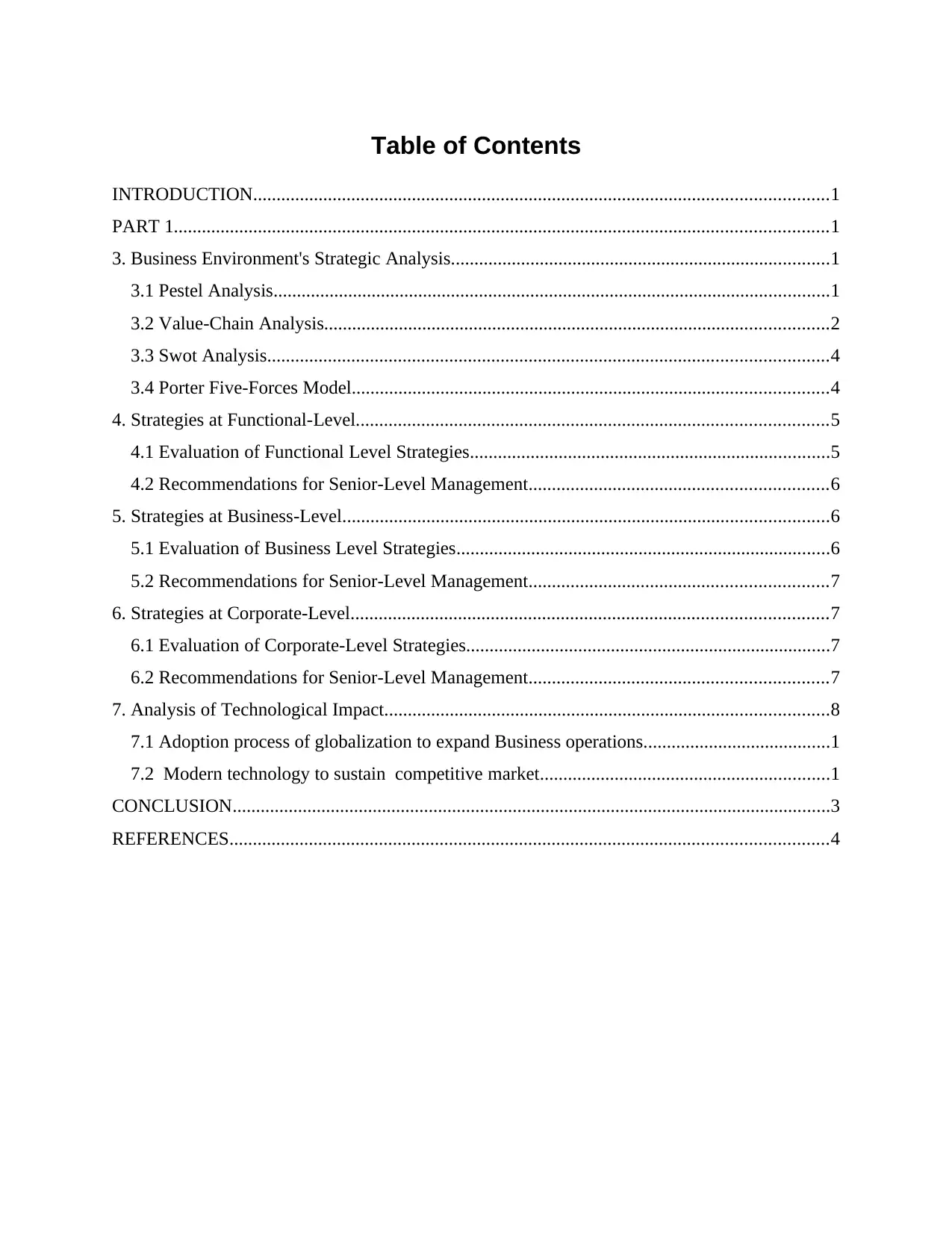
Table of Contents
INTRODUCTION...........................................................................................................................1
PART 1............................................................................................................................................1
3. Business Environment's Strategic Analysis.................................................................................1
3.1 Pestel Analysis.......................................................................................................................1
3.2 Value-Chain Analysis............................................................................................................2
3.3 Swot Analysis........................................................................................................................4
3.4 Porter Five-Forces Model......................................................................................................4
4. Strategies at Functional-Level.....................................................................................................5
4.1 Evaluation of Functional Level Strategies.............................................................................5
4.2 Recommendations for Senior-Level Management................................................................6
5. Strategies at Business-Level........................................................................................................6
5.1 Evaluation of Business Level Strategies................................................................................6
5.2 Recommendations for Senior-Level Management................................................................7
6. Strategies at Corporate-Level......................................................................................................7
6.1 Evaluation of Corporate-Level Strategies..............................................................................7
6.2 Recommendations for Senior-Level Management................................................................7
7. Analysis of Technological Impact...............................................................................................8
7.1 Adoption process of globalization to expand Business operations........................................1
7.2 Modern technology to sustain competitive market..............................................................1
CONCLUSION................................................................................................................................3
REFERENCES................................................................................................................................4
INTRODUCTION...........................................................................................................................1
PART 1............................................................................................................................................1
3. Business Environment's Strategic Analysis.................................................................................1
3.1 Pestel Analysis.......................................................................................................................1
3.2 Value-Chain Analysis............................................................................................................2
3.3 Swot Analysis........................................................................................................................4
3.4 Porter Five-Forces Model......................................................................................................4
4. Strategies at Functional-Level.....................................................................................................5
4.1 Evaluation of Functional Level Strategies.............................................................................5
4.2 Recommendations for Senior-Level Management................................................................6
5. Strategies at Business-Level........................................................................................................6
5.1 Evaluation of Business Level Strategies................................................................................6
5.2 Recommendations for Senior-Level Management................................................................7
6. Strategies at Corporate-Level......................................................................................................7
6.1 Evaluation of Corporate-Level Strategies..............................................................................7
6.2 Recommendations for Senior-Level Management................................................................7
7. Analysis of Technological Impact...............................................................................................8
7.1 Adoption process of globalization to expand Business operations........................................1
7.2 Modern technology to sustain competitive market..............................................................1
CONCLUSION................................................................................................................................3
REFERENCES................................................................................................................................4
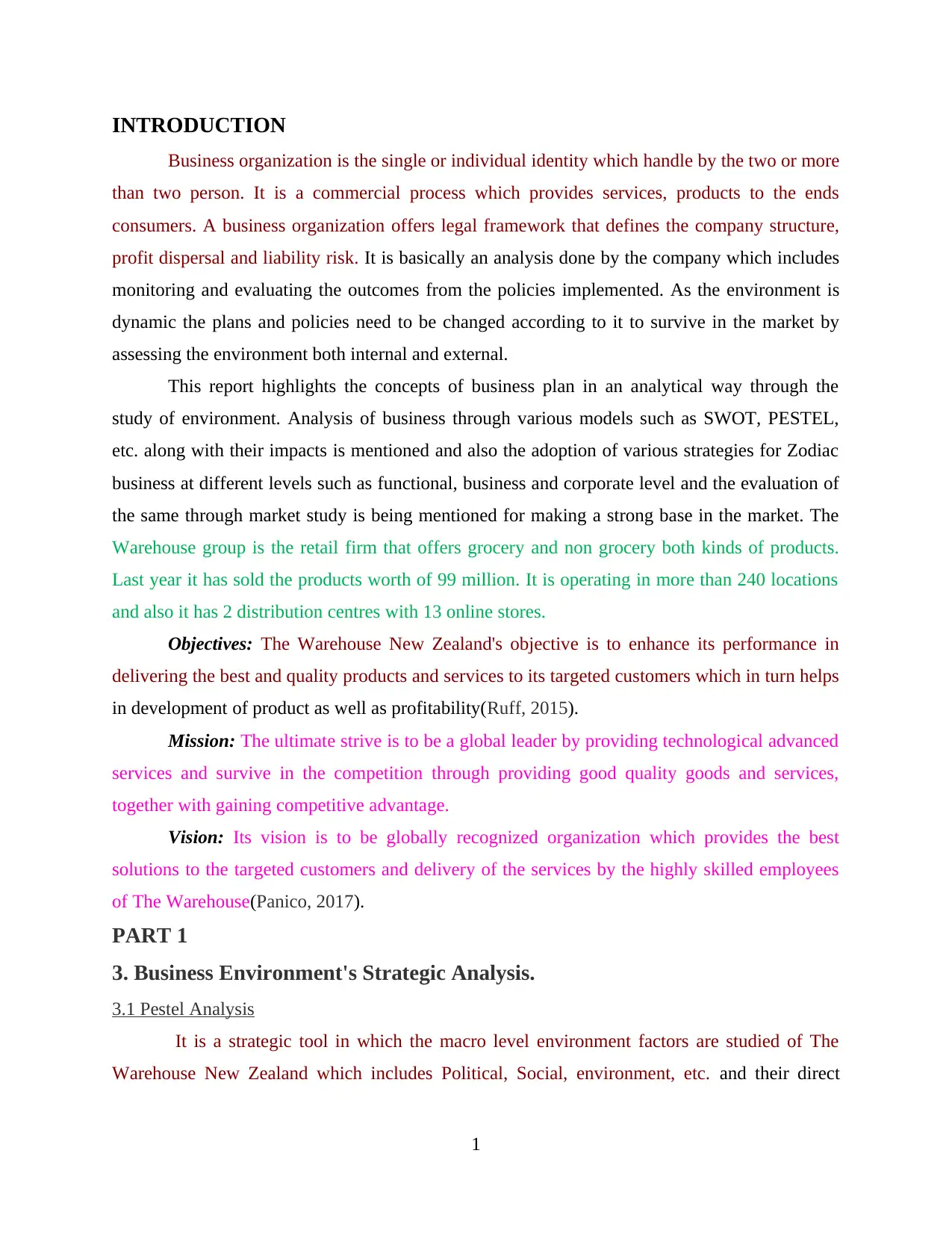
INTRODUCTION
Business organization is the single or individual identity which handle by the two or more
than two person. It is a commercial process which provides services, products to the ends
consumers. A business organization offers legal framework that defines the company structure,
profit dispersal and liability risk. It is basically an analysis done by the company which includes
monitoring and evaluating the outcomes from the policies implemented. As the environment is
dynamic the plans and policies need to be changed according to it to survive in the market by
assessing the environment both internal and external.
This report highlights the concepts of business plan in an analytical way through the
study of environment. Analysis of business through various models such as SWOT, PESTEL,
etc. along with their impacts is mentioned and also the adoption of various strategies for Zodiac
business at different levels such as functional, business and corporate level and the evaluation of
the same through market study is being mentioned for making a strong base in the market. The
Warehouse group is the retail firm that offers grocery and non grocery both kinds of products.
Last year it has sold the products worth of 99 million. It is operating in more than 240 locations
and also it has 2 distribution centres with 13 online stores.
Objectives: The Warehouse New Zealand's objective is to enhance its performance in
delivering the best and quality products and services to its targeted customers which in turn helps
in development of product as well as profitability(Ruff, 2015).
Mission: The ultimate strive is to be a global leader by providing technological advanced
services and survive in the competition through providing good quality goods and services,
together with gaining competitive advantage.
Vision: Its vision is to be globally recognized organization which provides the best
solutions to the targeted customers and delivery of the services by the highly skilled employees
of The Warehouse(Panico, 2017).
PART 1
3. Business Environment's Strategic Analysis.
3.1 Pestel Analysis
It is a strategic tool in which the macro level environment factors are studied of The
Warehouse New Zealand which includes Political, Social, environment, etc. and their direct
1
Business organization is the single or individual identity which handle by the two or more
than two person. It is a commercial process which provides services, products to the ends
consumers. A business organization offers legal framework that defines the company structure,
profit dispersal and liability risk. It is basically an analysis done by the company which includes
monitoring and evaluating the outcomes from the policies implemented. As the environment is
dynamic the plans and policies need to be changed according to it to survive in the market by
assessing the environment both internal and external.
This report highlights the concepts of business plan in an analytical way through the
study of environment. Analysis of business through various models such as SWOT, PESTEL,
etc. along with their impacts is mentioned and also the adoption of various strategies for Zodiac
business at different levels such as functional, business and corporate level and the evaluation of
the same through market study is being mentioned for making a strong base in the market. The
Warehouse group is the retail firm that offers grocery and non grocery both kinds of products.
Last year it has sold the products worth of 99 million. It is operating in more than 240 locations
and also it has 2 distribution centres with 13 online stores.
Objectives: The Warehouse New Zealand's objective is to enhance its performance in
delivering the best and quality products and services to its targeted customers which in turn helps
in development of product as well as profitability(Ruff, 2015).
Mission: The ultimate strive is to be a global leader by providing technological advanced
services and survive in the competition through providing good quality goods and services,
together with gaining competitive advantage.
Vision: Its vision is to be globally recognized organization which provides the best
solutions to the targeted customers and delivery of the services by the highly skilled employees
of The Warehouse(Panico, 2017).
PART 1
3. Business Environment's Strategic Analysis.
3.1 Pestel Analysis
It is a strategic tool in which the macro level environment factors are studied of The
Warehouse New Zealand which includes Political, Social, environment, etc. and their direct
1
⊘ This is a preview!⊘
Do you want full access?
Subscribe today to unlock all pages.

Trusted by 1+ million students worldwide
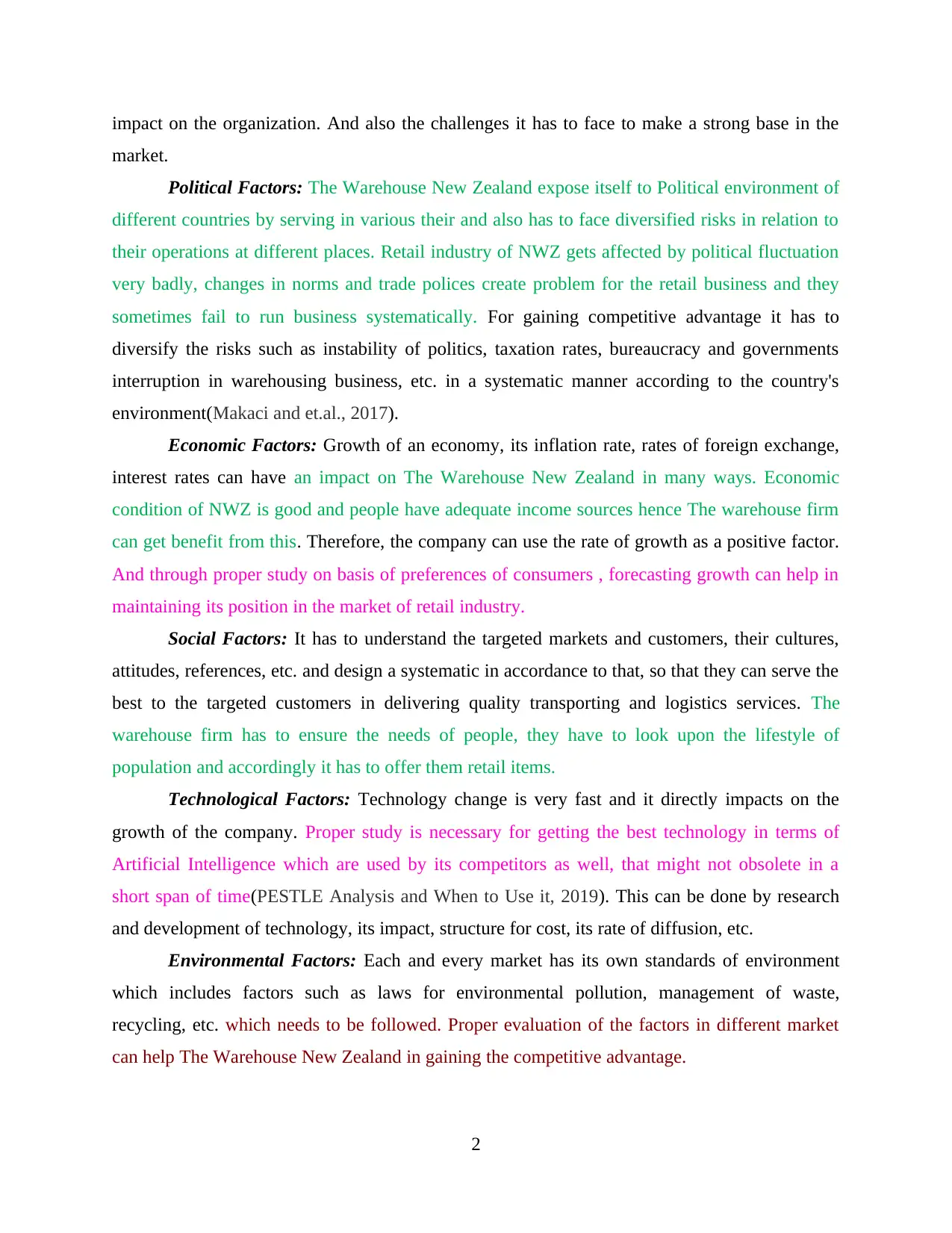
impact on the organization. And also the challenges it has to face to make a strong base in the
market.
Political Factors: The Warehouse New Zealand expose itself to Political environment of
different countries by serving in various their and also has to face diversified risks in relation to
their operations at different places. Retail industry of NWZ gets affected by political fluctuation
very badly, changes in norms and trade polices create problem for the retail business and they
sometimes fail to run business systematically. For gaining competitive advantage it has to
diversify the risks such as instability of politics, taxation rates, bureaucracy and governments
interruption in warehousing business, etc. in a systematic manner according to the country's
environment(Makaci and et.al., 2017).
Economic Factors: Growth of an economy, its inflation rate, rates of foreign exchange,
interest rates can have an impact on The Warehouse New Zealand in many ways. Economic
condition of NWZ is good and people have adequate income sources hence The warehouse firm
can get benefit from this. Therefore, the company can use the rate of growth as a positive factor.
And through proper study on basis of preferences of consumers , forecasting growth can help in
maintaining its position in the market of retail industry.
Social Factors: It has to understand the targeted markets and customers, their cultures,
attitudes, references, etc. and design a systematic in accordance to that, so that they can serve the
best to the targeted customers in delivering quality transporting and logistics services. The
warehouse firm has to ensure the needs of people, they have to look upon the lifestyle of
population and accordingly it has to offer them retail items.
Technological Factors: Technology change is very fast and it directly impacts on the
growth of the company. Proper study is necessary for getting the best technology in terms of
Artificial Intelligence which are used by its competitors as well, that might not obsolete in a
short span of time(PESTLE Analysis and When to Use it, 2019). This can be done by research
and development of technology, its impact, structure for cost, its rate of diffusion, etc.
Environmental Factors: Each and every market has its own standards of environment
which includes factors such as laws for environmental pollution, management of waste,
recycling, etc. which needs to be followed. Proper evaluation of the factors in different market
can help The Warehouse New Zealand in gaining the competitive advantage.
2
market.
Political Factors: The Warehouse New Zealand expose itself to Political environment of
different countries by serving in various their and also has to face diversified risks in relation to
their operations at different places. Retail industry of NWZ gets affected by political fluctuation
very badly, changes in norms and trade polices create problem for the retail business and they
sometimes fail to run business systematically. For gaining competitive advantage it has to
diversify the risks such as instability of politics, taxation rates, bureaucracy and governments
interruption in warehousing business, etc. in a systematic manner according to the country's
environment(Makaci and et.al., 2017).
Economic Factors: Growth of an economy, its inflation rate, rates of foreign exchange,
interest rates can have an impact on The Warehouse New Zealand in many ways. Economic
condition of NWZ is good and people have adequate income sources hence The warehouse firm
can get benefit from this. Therefore, the company can use the rate of growth as a positive factor.
And through proper study on basis of preferences of consumers , forecasting growth can help in
maintaining its position in the market of retail industry.
Social Factors: It has to understand the targeted markets and customers, their cultures,
attitudes, references, etc. and design a systematic in accordance to that, so that they can serve the
best to the targeted customers in delivering quality transporting and logistics services. The
warehouse firm has to ensure the needs of people, they have to look upon the lifestyle of
population and accordingly it has to offer them retail items.
Technological Factors: Technology change is very fast and it directly impacts on the
growth of the company. Proper study is necessary for getting the best technology in terms of
Artificial Intelligence which are used by its competitors as well, that might not obsolete in a
short span of time(PESTLE Analysis and When to Use it, 2019). This can be done by research
and development of technology, its impact, structure for cost, its rate of diffusion, etc.
Environmental Factors: Each and every market has its own standards of environment
which includes factors such as laws for environmental pollution, management of waste,
recycling, etc. which needs to be followed. Proper evaluation of the factors in different market
can help The Warehouse New Zealand in gaining the competitive advantage.
2
Paraphrase This Document
Need a fresh take? Get an instant paraphrase of this document with our AI Paraphraser
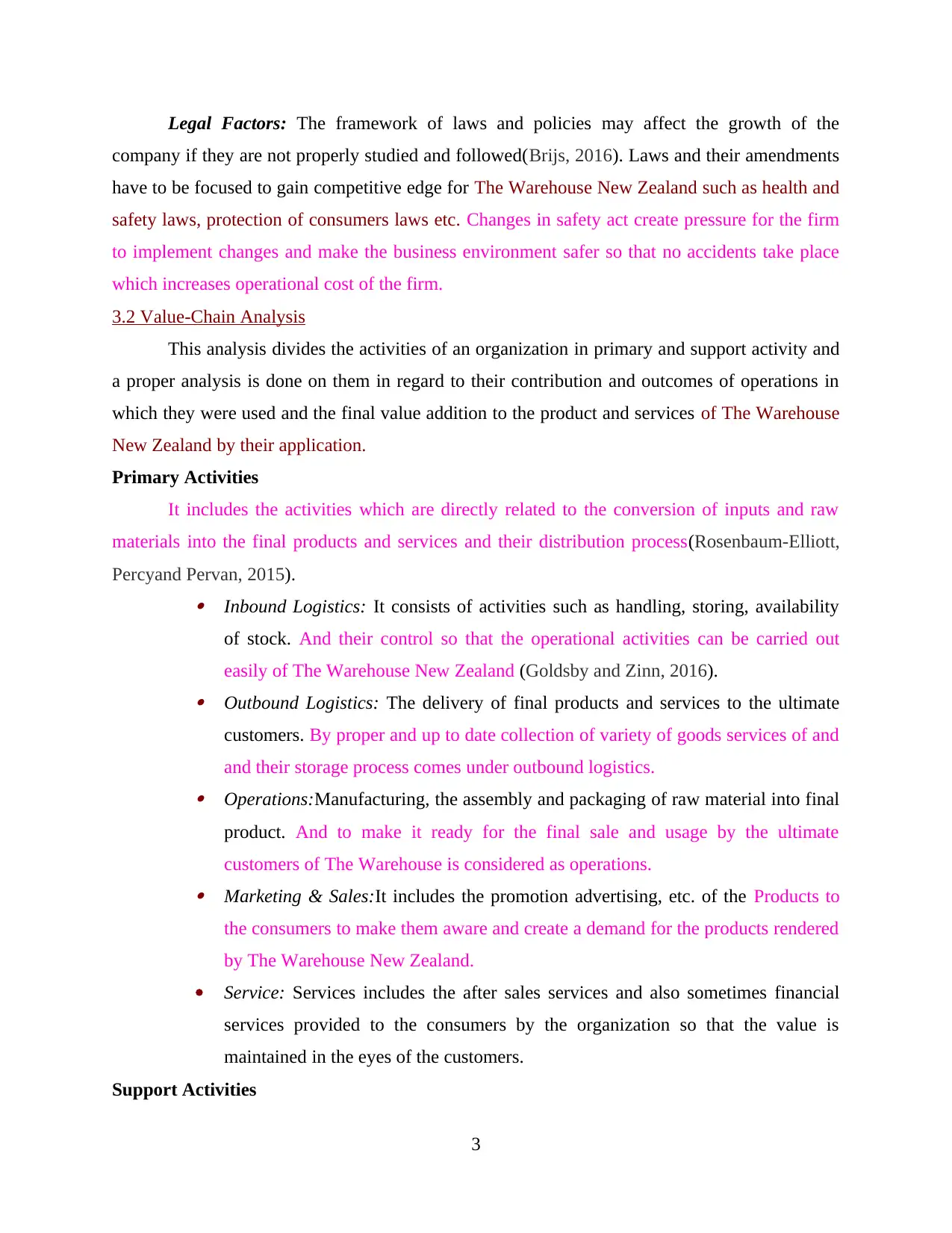
Legal Factors: The framework of laws and policies may affect the growth of the
company if they are not properly studied and followed(Brijs, 2016). Laws and their amendments
have to be focused to gain competitive edge for The Warehouse New Zealand such as health and
safety laws, protection of consumers laws etc. Changes in safety act create pressure for the firm
to implement changes and make the business environment safer so that no accidents take place
which increases operational cost of the firm.
3.2 Value-Chain Analysis
This analysis divides the activities of an organization in primary and support activity and
a proper analysis is done on them in regard to their contribution and outcomes of operations in
which they were used and the final value addition to the product and services of The Warehouse
New Zealand by their application.
Primary Activities
It includes the activities which are directly related to the conversion of inputs and raw
materials into the final products and services and their distribution process(Rosenbaum-Elliott,
Percyand Pervan, 2015).
Inbound Logistics: It consists of activities such as handling, storing, availability
of stock. And their control so that the operational activities can be carried out
easily of The Warehouse New Zealand (Goldsby and Zinn, 2016).
Outbound Logistics: The delivery of final products and services to the ultimate
customers. By proper and up to date collection of variety of goods services of and
and their storage process comes under outbound logistics.
Operations:Manufacturing, the assembly and packaging of raw material into final
product. And to make it ready for the final sale and usage by the ultimate
customers of The Warehouse is considered as operations.
Marketing & Sales:It includes the promotion advertising, etc. of the Products to
the consumers to make them aware and create a demand for the products rendered
by The Warehouse New Zealand.
Service: Services includes the after sales services and also sometimes financial
services provided to the consumers by the organization so that the value is
maintained in the eyes of the customers.
Support Activities
3
company if they are not properly studied and followed(Brijs, 2016). Laws and their amendments
have to be focused to gain competitive edge for The Warehouse New Zealand such as health and
safety laws, protection of consumers laws etc. Changes in safety act create pressure for the firm
to implement changes and make the business environment safer so that no accidents take place
which increases operational cost of the firm.
3.2 Value-Chain Analysis
This analysis divides the activities of an organization in primary and support activity and
a proper analysis is done on them in regard to their contribution and outcomes of operations in
which they were used and the final value addition to the product and services of The Warehouse
New Zealand by their application.
Primary Activities
It includes the activities which are directly related to the conversion of inputs and raw
materials into the final products and services and their distribution process(Rosenbaum-Elliott,
Percyand Pervan, 2015).
Inbound Logistics: It consists of activities such as handling, storing, availability
of stock. And their control so that the operational activities can be carried out
easily of The Warehouse New Zealand (Goldsby and Zinn, 2016).
Outbound Logistics: The delivery of final products and services to the ultimate
customers. By proper and up to date collection of variety of goods services of and
and their storage process comes under outbound logistics.
Operations:Manufacturing, the assembly and packaging of raw material into final
product. And to make it ready for the final sale and usage by the ultimate
customers of The Warehouse is considered as operations.
Marketing & Sales:It includes the promotion advertising, etc. of the Products to
the consumers to make them aware and create a demand for the products rendered
by The Warehouse New Zealand.
Service: Services includes the after sales services and also sometimes financial
services provided to the consumers by the organization so that the value is
maintained in the eyes of the customers.
Support Activities
3
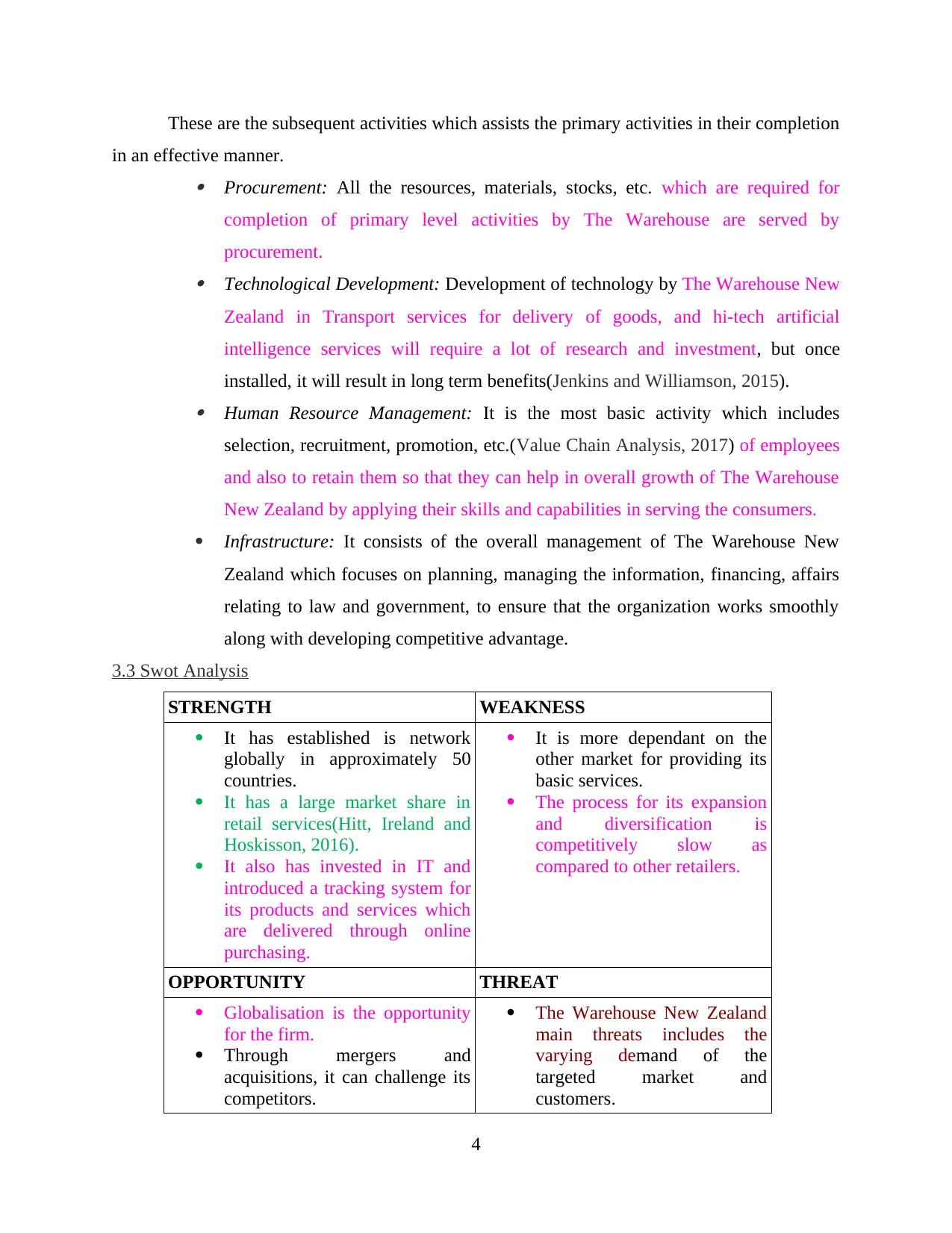
These are the subsequent activities which assists the primary activities in their completion
in an effective manner.
Procurement: All the resources, materials, stocks, etc. which are required for
completion of primary level activities by The Warehouse are served by
procurement.
Technological Development: Development of technology by The Warehouse New
Zealand in Transport services for delivery of goods, and hi-tech artificial
intelligence services will require a lot of research and investment, but once
installed, it will result in long term benefits(Jenkins and Williamson, 2015).
Human Resource Management: It is the most basic activity which includes
selection, recruitment, promotion, etc.(Value Chain Analysis, 2017) of employees
and also to retain them so that they can help in overall growth of The Warehouse
New Zealand by applying their skills and capabilities in serving the consumers.
Infrastructure: It consists of the overall management of The Warehouse New
Zealand which focuses on planning, managing the information, financing, affairs
relating to law and government, to ensure that the organization works smoothly
along with developing competitive advantage.
3.3 Swot Analysis
STRENGTH WEAKNESS
It has established is network
globally in approximately 50
countries.
It has a large market share in
retail services(Hitt, Ireland and
Hoskisson, 2016).
It also has invested in IT and
introduced a tracking system for
its products and services which
are delivered through online
purchasing.
It is more dependant on the
other market for providing its
basic services.
The process for its expansion
and diversification is
competitively slow as
compared to other retailers.
OPPORTUNITY THREAT
Globalisation is the opportunity
for the firm.
Through mergers and
acquisitions, it can challenge its
competitors.
The Warehouse New Zealand
main threats includes the
varying demand of the
targeted market and
customers.
4
in an effective manner.
Procurement: All the resources, materials, stocks, etc. which are required for
completion of primary level activities by The Warehouse are served by
procurement.
Technological Development: Development of technology by The Warehouse New
Zealand in Transport services for delivery of goods, and hi-tech artificial
intelligence services will require a lot of research and investment, but once
installed, it will result in long term benefits(Jenkins and Williamson, 2015).
Human Resource Management: It is the most basic activity which includes
selection, recruitment, promotion, etc.(Value Chain Analysis, 2017) of employees
and also to retain them so that they can help in overall growth of The Warehouse
New Zealand by applying their skills and capabilities in serving the consumers.
Infrastructure: It consists of the overall management of The Warehouse New
Zealand which focuses on planning, managing the information, financing, affairs
relating to law and government, to ensure that the organization works smoothly
along with developing competitive advantage.
3.3 Swot Analysis
STRENGTH WEAKNESS
It has established is network
globally in approximately 50
countries.
It has a large market share in
retail services(Hitt, Ireland and
Hoskisson, 2016).
It also has invested in IT and
introduced a tracking system for
its products and services which
are delivered through online
purchasing.
It is more dependant on the
other market for providing its
basic services.
The process for its expansion
and diversification is
competitively slow as
compared to other retailers.
OPPORTUNITY THREAT
Globalisation is the opportunity
for the firm.
Through mergers and
acquisitions, it can challenge its
competitors.
The Warehouse New Zealand
main threats includes the
varying demand of the
targeted market and
customers.
4
⊘ This is a preview!⊘
Do you want full access?
Subscribe today to unlock all pages.

Trusted by 1+ million students worldwide
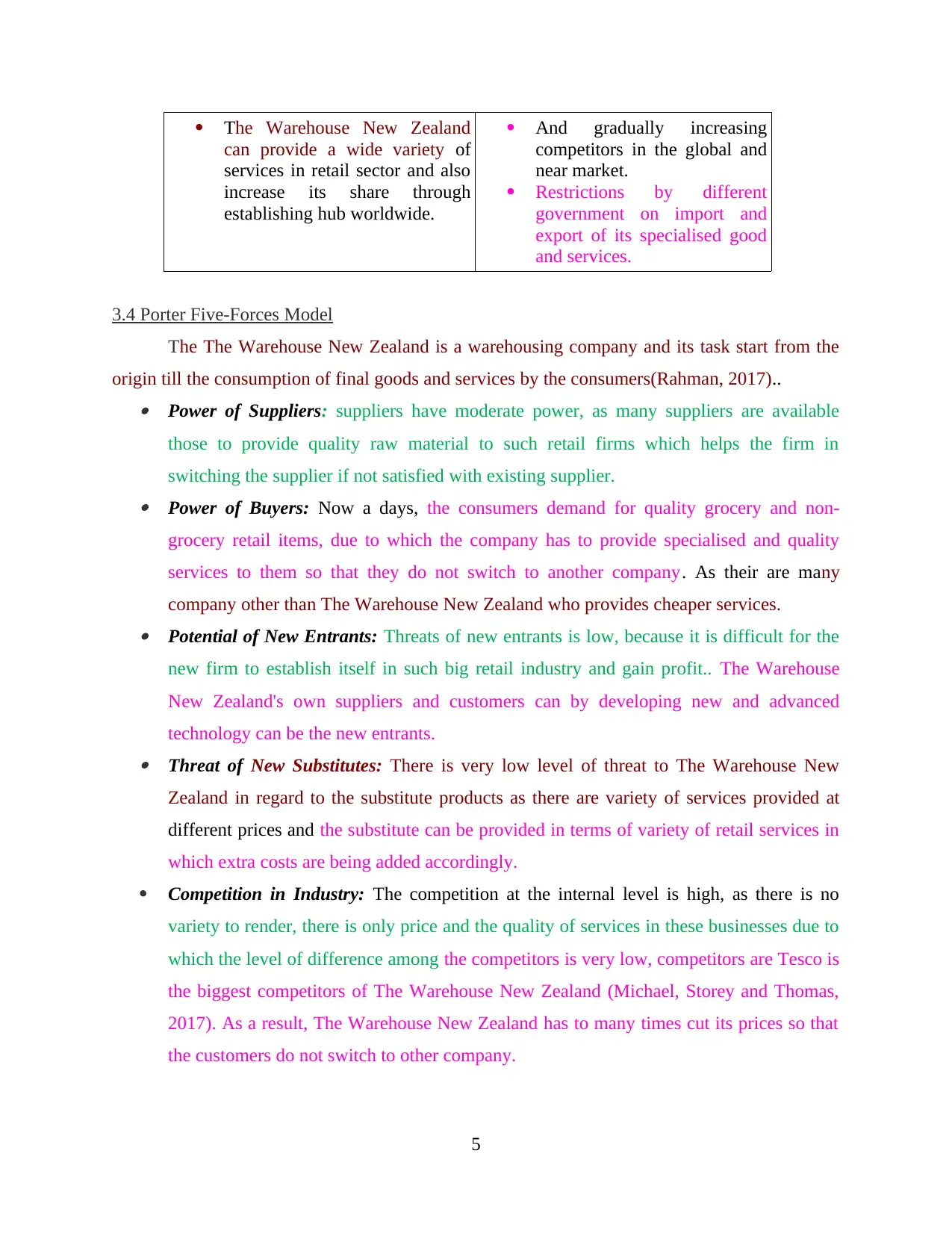
The Warehouse New Zealand
can provide a wide variety of
services in retail sector and also
increase its share through
establishing hub worldwide.
And gradually increasing
competitors in the global and
near market.
Restrictions by different
government on import and
export of its specialised good
and services.
3.4 Porter Five-Forces Model
The The Warehouse New Zealand is a warehousing company and its task start from the
origin till the consumption of final goods and services by the consumers(Rahman, 2017).. Power of Suppliers: suppliers have moderate power, as many suppliers are available
those to provide quality raw material to such retail firms which helps the firm in
switching the supplier if not satisfied with existing supplier. Power of Buyers: Now a days, the consumers demand for quality grocery and non-
grocery retail items, due to which the company has to provide specialised and quality
services to them so that they do not switch to another company. As their are many
company other than The Warehouse New Zealand who provides cheaper services. Potential of New Entrants: Threats of new entrants is low, because it is difficult for the
new firm to establish itself in such big retail industry and gain profit.. The Warehouse
New Zealand's own suppliers and customers can by developing new and advanced
technology can be the new entrants. Threat of New Substitutes: There is very low level of threat to The Warehouse New
Zealand in regard to the substitute products as there are variety of services provided at
different prices and the substitute can be provided in terms of variety of retail services in
which extra costs are being added accordingly.
Competition in Industry: The competition at the internal level is high, as there is no
variety to render, there is only price and the quality of services in these businesses due to
which the level of difference among the competitors is very low, competitors are Tesco is
the biggest competitors of The Warehouse New Zealand (Michael, Storey and Thomas,
2017). As a result, The Warehouse New Zealand has to many times cut its prices so that
the customers do not switch to other company.
5
can provide a wide variety of
services in retail sector and also
increase its share through
establishing hub worldwide.
And gradually increasing
competitors in the global and
near market.
Restrictions by different
government on import and
export of its specialised good
and services.
3.4 Porter Five-Forces Model
The The Warehouse New Zealand is a warehousing company and its task start from the
origin till the consumption of final goods and services by the consumers(Rahman, 2017).. Power of Suppliers: suppliers have moderate power, as many suppliers are available
those to provide quality raw material to such retail firms which helps the firm in
switching the supplier if not satisfied with existing supplier. Power of Buyers: Now a days, the consumers demand for quality grocery and non-
grocery retail items, due to which the company has to provide specialised and quality
services to them so that they do not switch to another company. As their are many
company other than The Warehouse New Zealand who provides cheaper services. Potential of New Entrants: Threats of new entrants is low, because it is difficult for the
new firm to establish itself in such big retail industry and gain profit.. The Warehouse
New Zealand's own suppliers and customers can by developing new and advanced
technology can be the new entrants. Threat of New Substitutes: There is very low level of threat to The Warehouse New
Zealand in regard to the substitute products as there are variety of services provided at
different prices and the substitute can be provided in terms of variety of retail services in
which extra costs are being added accordingly.
Competition in Industry: The competition at the internal level is high, as there is no
variety to render, there is only price and the quality of services in these businesses due to
which the level of difference among the competitors is very low, competitors are Tesco is
the biggest competitors of The Warehouse New Zealand (Michael, Storey and Thomas,
2017). As a result, The Warehouse New Zealand has to many times cut its prices so that
the customers do not switch to other company.
5
Paraphrase This Document
Need a fresh take? Get an instant paraphrase of this document with our AI Paraphraser
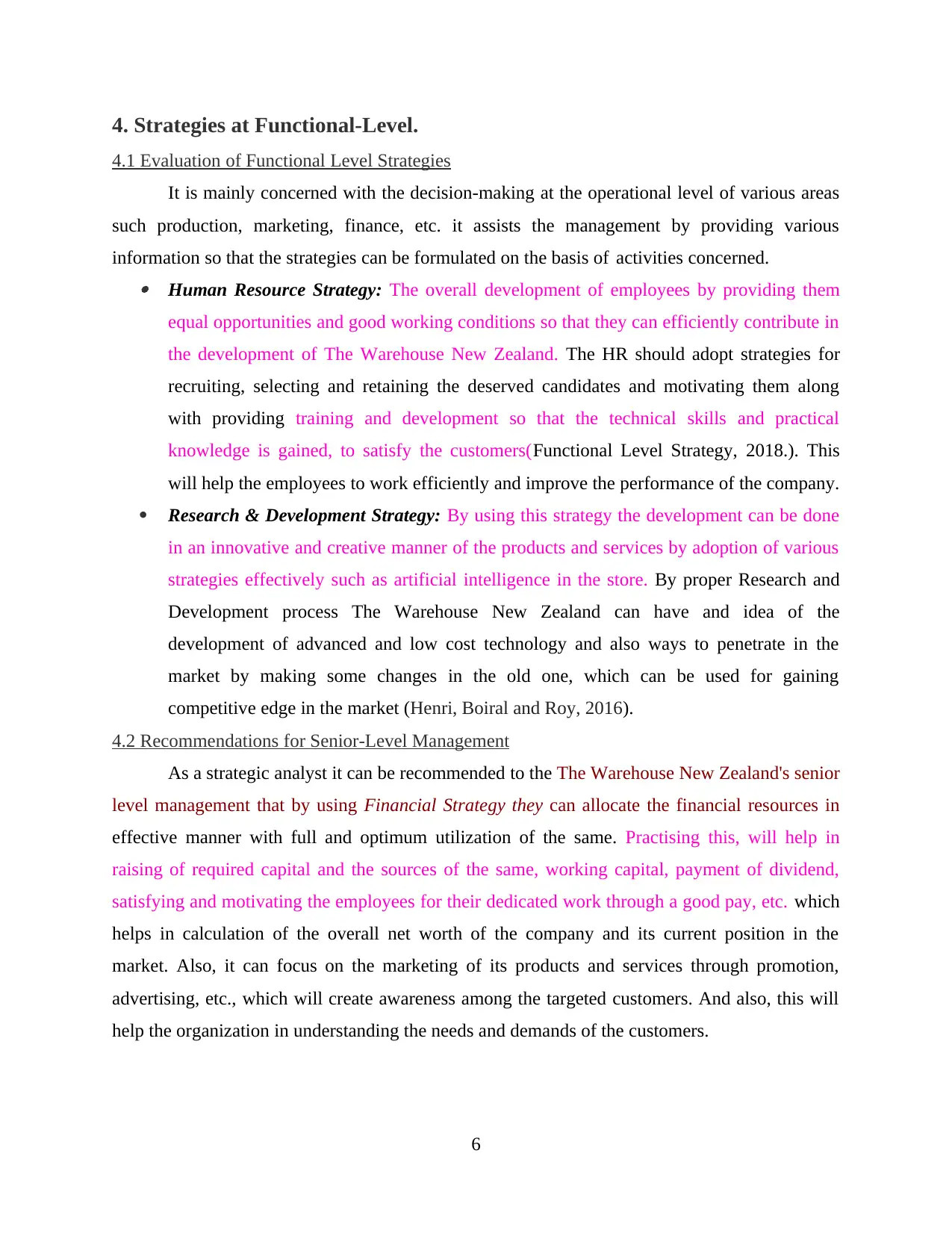
4. Strategies at Functional-Level.
4.1 Evaluation of Functional Level Strategies
It is mainly concerned with the decision-making at the operational level of various areas
such production, marketing, finance, etc. it assists the management by providing various
information so that the strategies can be formulated on the basis of activities concerned. Human Resource Strategy: The overall development of employees by providing them
equal opportunities and good working conditions so that they can efficiently contribute in
the development of The Warehouse New Zealand. The HR should adopt strategies for
recruiting, selecting and retaining the deserved candidates and motivating them along
with providing training and development so that the technical skills and practical
knowledge is gained, to satisfy the customers(Functional Level Strategy, 2018.). This
will help the employees to work efficiently and improve the performance of the company.
Research & Development Strategy: By using this strategy the development can be done
in an innovative and creative manner of the products and services by adoption of various
strategies effectively such as artificial intelligence in the store. By proper Research and
Development process The Warehouse New Zealand can have and idea of the
development of advanced and low cost technology and also ways to penetrate in the
market by making some changes in the old one, which can be used for gaining
competitive edge in the market (Henri, Boiral and Roy, 2016).
4.2 Recommendations for Senior-Level Management
As a strategic analyst it can be recommended to the The Warehouse New Zealand's senior
level management that by using Financial Strategy they can allocate the financial resources in
effective manner with full and optimum utilization of the same. Practising this, will help in
raising of required capital and the sources of the same, working capital, payment of dividend,
satisfying and motivating the employees for their dedicated work through a good pay, etc. which
helps in calculation of the overall net worth of the company and its current position in the
market. Also, it can focus on the marketing of its products and services through promotion,
advertising, etc., which will create awareness among the targeted customers. And also, this will
help the organization in understanding the needs and demands of the customers.
6
4.1 Evaluation of Functional Level Strategies
It is mainly concerned with the decision-making at the operational level of various areas
such production, marketing, finance, etc. it assists the management by providing various
information so that the strategies can be formulated on the basis of activities concerned. Human Resource Strategy: The overall development of employees by providing them
equal opportunities and good working conditions so that they can efficiently contribute in
the development of The Warehouse New Zealand. The HR should adopt strategies for
recruiting, selecting and retaining the deserved candidates and motivating them along
with providing training and development so that the technical skills and practical
knowledge is gained, to satisfy the customers(Functional Level Strategy, 2018.). This
will help the employees to work efficiently and improve the performance of the company.
Research & Development Strategy: By using this strategy the development can be done
in an innovative and creative manner of the products and services by adoption of various
strategies effectively such as artificial intelligence in the store. By proper Research and
Development process The Warehouse New Zealand can have and idea of the
development of advanced and low cost technology and also ways to penetrate in the
market by making some changes in the old one, which can be used for gaining
competitive edge in the market (Henri, Boiral and Roy, 2016).
4.2 Recommendations for Senior-Level Management
As a strategic analyst it can be recommended to the The Warehouse New Zealand's senior
level management that by using Financial Strategy they can allocate the financial resources in
effective manner with full and optimum utilization of the same. Practising this, will help in
raising of required capital and the sources of the same, working capital, payment of dividend,
satisfying and motivating the employees for their dedicated work through a good pay, etc. which
helps in calculation of the overall net worth of the company and its current position in the
market. Also, it can focus on the marketing of its products and services through promotion,
advertising, etc., which will create awareness among the targeted customers. And also, this will
help the organization in understanding the needs and demands of the customers.
6
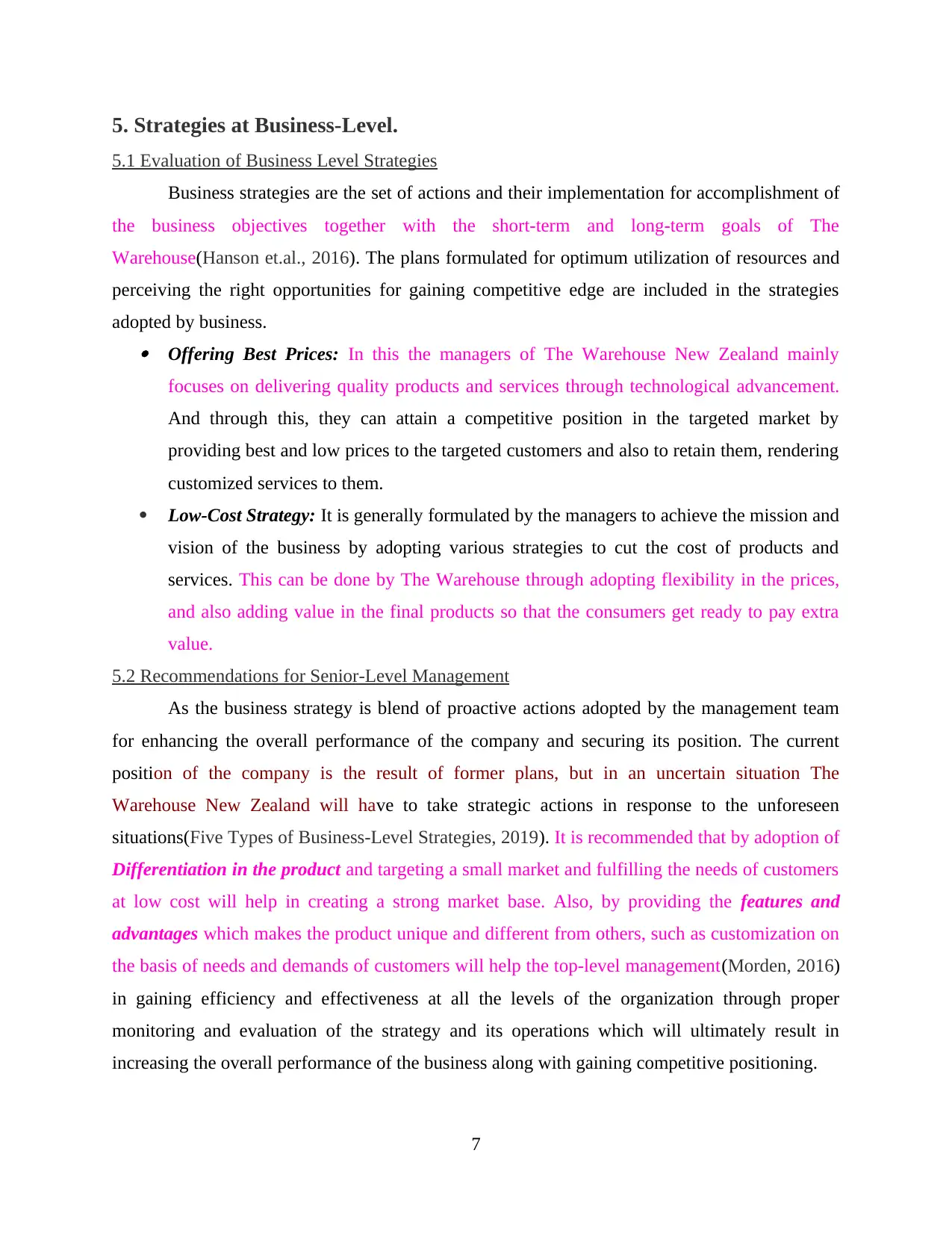
5. Strategies at Business-Level.
5.1 Evaluation of Business Level Strategies
Business strategies are the set of actions and their implementation for accomplishment of
the business objectives together with the short-term and long-term goals of The
Warehouse(Hanson et.al., 2016). The plans formulated for optimum utilization of resources and
perceiving the right opportunities for gaining competitive edge are included in the strategies
adopted by business. Offering Best Prices: In this the managers of The Warehouse New Zealand mainly
focuses on delivering quality products and services through technological advancement.
And through this, they can attain a competitive position in the targeted market by
providing best and low prices to the targeted customers and also to retain them, rendering
customized services to them.
Low-Cost Strategy: It is generally formulated by the managers to achieve the mission and
vision of the business by adopting various strategies to cut the cost of products and
services. This can be done by The Warehouse through adopting flexibility in the prices,
and also adding value in the final products so that the consumers get ready to pay extra
value.
5.2 Recommendations for Senior-Level Management
As the business strategy is blend of proactive actions adopted by the management team
for enhancing the overall performance of the company and securing its position. The current
position of the company is the result of former plans, but in an uncertain situation The
Warehouse New Zealand will have to take strategic actions in response to the unforeseen
situations(Five Types of Business-Level Strategies, 2019). It is recommended that by adoption of
Differentiation in the product and targeting a small market and fulfilling the needs of customers
at low cost will help in creating a strong market base. Also, by providing the features and
advantages which makes the product unique and different from others, such as customization on
the basis of needs and demands of customers will help the top-level management(Morden, 2016)
in gaining efficiency and effectiveness at all the levels of the organization through proper
monitoring and evaluation of the strategy and its operations which will ultimately result in
increasing the overall performance of the business along with gaining competitive positioning.
7
5.1 Evaluation of Business Level Strategies
Business strategies are the set of actions and their implementation for accomplishment of
the business objectives together with the short-term and long-term goals of The
Warehouse(Hanson et.al., 2016). The plans formulated for optimum utilization of resources and
perceiving the right opportunities for gaining competitive edge are included in the strategies
adopted by business. Offering Best Prices: In this the managers of The Warehouse New Zealand mainly
focuses on delivering quality products and services through technological advancement.
And through this, they can attain a competitive position in the targeted market by
providing best and low prices to the targeted customers and also to retain them, rendering
customized services to them.
Low-Cost Strategy: It is generally formulated by the managers to achieve the mission and
vision of the business by adopting various strategies to cut the cost of products and
services. This can be done by The Warehouse through adopting flexibility in the prices,
and also adding value in the final products so that the consumers get ready to pay extra
value.
5.2 Recommendations for Senior-Level Management
As the business strategy is blend of proactive actions adopted by the management team
for enhancing the overall performance of the company and securing its position. The current
position of the company is the result of former plans, but in an uncertain situation The
Warehouse New Zealand will have to take strategic actions in response to the unforeseen
situations(Five Types of Business-Level Strategies, 2019). It is recommended that by adoption of
Differentiation in the product and targeting a small market and fulfilling the needs of customers
at low cost will help in creating a strong market base. Also, by providing the features and
advantages which makes the product unique and different from others, such as customization on
the basis of needs and demands of customers will help the top-level management(Morden, 2016)
in gaining efficiency and effectiveness at all the levels of the organization through proper
monitoring and evaluation of the strategy and its operations which will ultimately result in
increasing the overall performance of the business along with gaining competitive positioning.
7
⊘ This is a preview!⊘
Do you want full access?
Subscribe today to unlock all pages.

Trusted by 1+ million students worldwide
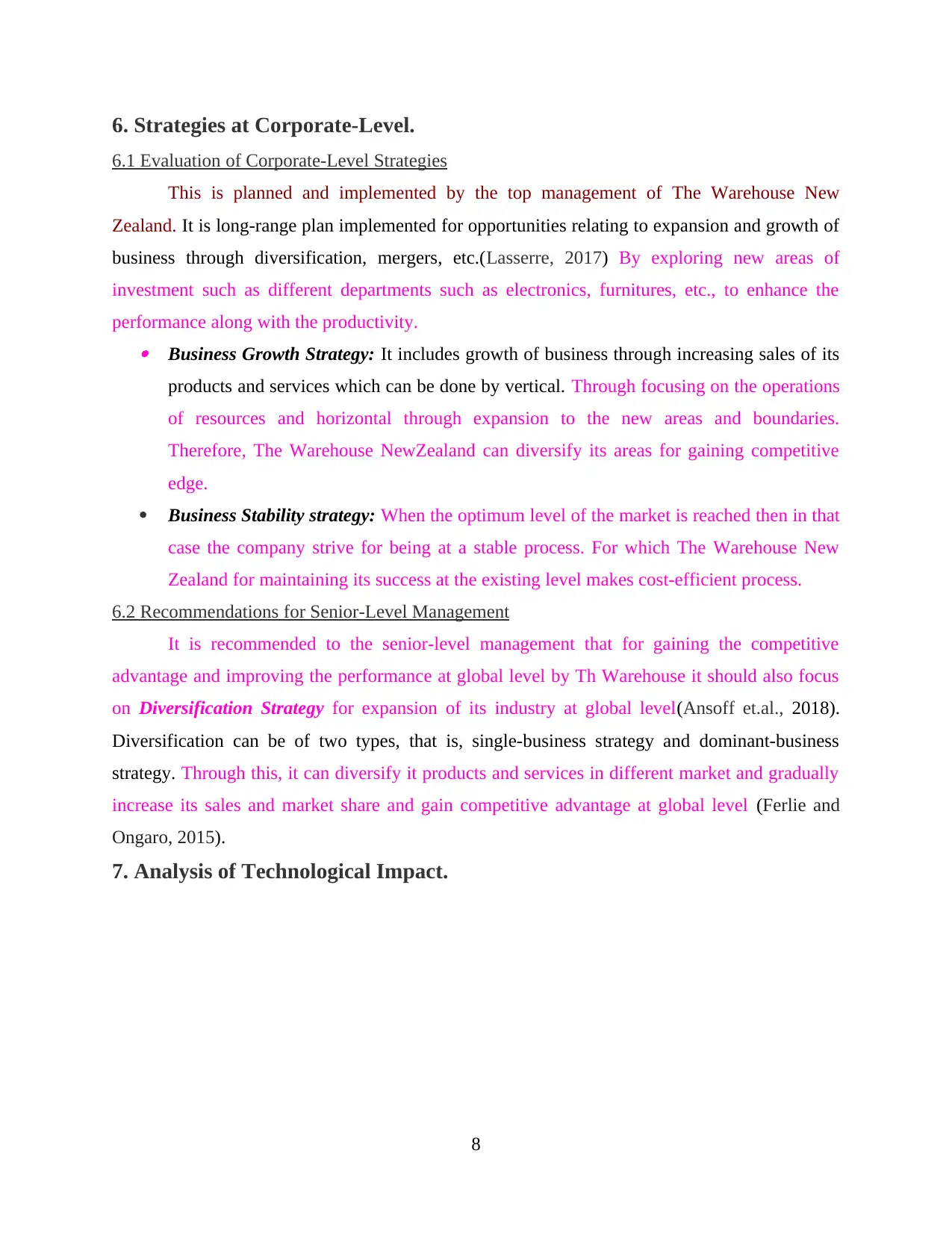
6. Strategies at Corporate-Level.
6.1 Evaluation of Corporate-Level Strategies
This is planned and implemented by the top management of The Warehouse New
Zealand. It is long-range plan implemented for opportunities relating to expansion and growth of
business through diversification, mergers, etc.(Lasserre, 2017) By exploring new areas of
investment such as different departments such as electronics, furnitures, etc., to enhance the
performance along with the productivity. Business Growth Strategy: It includes growth of business through increasing sales of its
products and services which can be done by vertical. Through focusing on the operations
of resources and horizontal through expansion to the new areas and boundaries.
Therefore, The Warehouse NewZealand can diversify its areas for gaining competitive
edge.
Business Stability strategy: When the optimum level of the market is reached then in that
case the company strive for being at a stable process. For which The Warehouse New
Zealand for maintaining its success at the existing level makes cost-efficient process.
6.2 Recommendations for Senior-Level Management
It is recommended to the senior-level management that for gaining the competitive
advantage and improving the performance at global level by Th Warehouse it should also focus
on Diversification Strategy for expansion of its industry at global level(Ansoff et.al., 2018).
Diversification can be of two types, that is, single-business strategy and dominant-business
strategy. Through this, it can diversify it products and services in different market and gradually
increase its sales and market share and gain competitive advantage at global level (Ferlie and
Ongaro, 2015).
7. Analysis of Technological Impact.
8
6.1 Evaluation of Corporate-Level Strategies
This is planned and implemented by the top management of The Warehouse New
Zealand. It is long-range plan implemented for opportunities relating to expansion and growth of
business through diversification, mergers, etc.(Lasserre, 2017) By exploring new areas of
investment such as different departments such as electronics, furnitures, etc., to enhance the
performance along with the productivity. Business Growth Strategy: It includes growth of business through increasing sales of its
products and services which can be done by vertical. Through focusing on the operations
of resources and horizontal through expansion to the new areas and boundaries.
Therefore, The Warehouse NewZealand can diversify its areas for gaining competitive
edge.
Business Stability strategy: When the optimum level of the market is reached then in that
case the company strive for being at a stable process. For which The Warehouse New
Zealand for maintaining its success at the existing level makes cost-efficient process.
6.2 Recommendations for Senior-Level Management
It is recommended to the senior-level management that for gaining the competitive
advantage and improving the performance at global level by Th Warehouse it should also focus
on Diversification Strategy for expansion of its industry at global level(Ansoff et.al., 2018).
Diversification can be of two types, that is, single-business strategy and dominant-business
strategy. Through this, it can diversify it products and services in different market and gradually
increase its sales and market share and gain competitive advantage at global level (Ferlie and
Ongaro, 2015).
7. Analysis of Technological Impact.
8
Paraphrase This Document
Need a fresh take? Get an instant paraphrase of this document with our AI Paraphraser
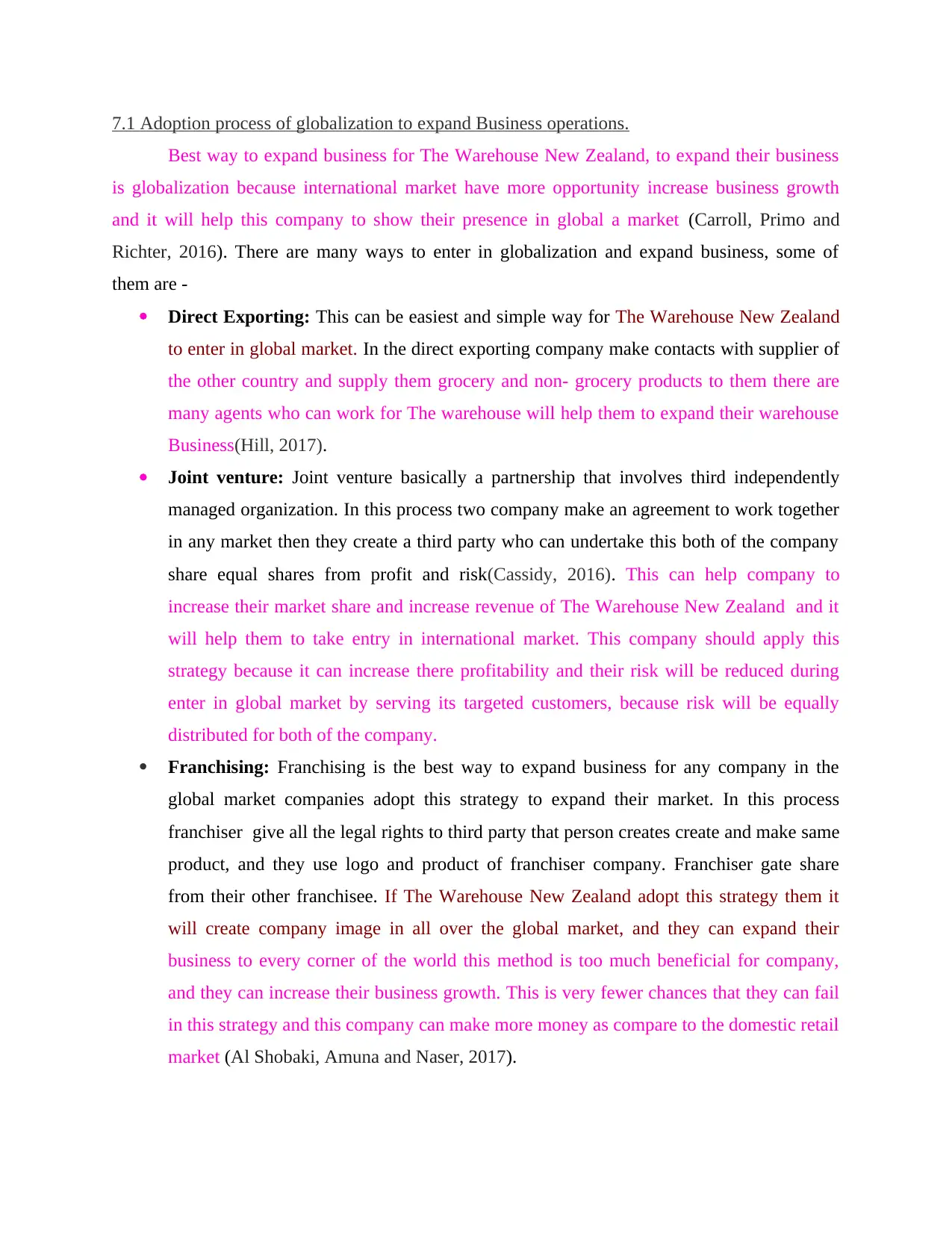
7.1 Adoption process of globalization to expand Business operations.
Best way to expand business for The Warehouse New Zealand, to expand their business
is globalization because international market have more opportunity increase business growth
and it will help this company to show their presence in global a market (Carroll, Primo and
Richter, 2016). There are many ways to enter in globalization and expand business, some of
them are -
Direct Exporting: This can be easiest and simple way for The Warehouse New Zealand
to enter in global market. In the direct exporting company make contacts with supplier of
the other country and supply them grocery and non- grocery products to them there are
many agents who can work for The warehouse will help them to expand their warehouse
Business(Hill, 2017).
Joint venture: Joint venture basically a partnership that involves third independently
managed organization. In this process two company make an agreement to work together
in any market then they create a third party who can undertake this both of the company
share equal shares from profit and risk(Cassidy, 2016). This can help company to
increase their market share and increase revenue of The Warehouse New Zealand and it
will help them to take entry in international market. This company should apply this
strategy because it can increase there profitability and their risk will be reduced during
enter in global market by serving its targeted customers, because risk will be equally
distributed for both of the company.
Franchising: Franchising is the best way to expand business for any company in the
global market companies adopt this strategy to expand their market. In this process
franchiser give all the legal rights to third party that person creates create and make same
product, and they use logo and product of franchiser company. Franchiser gate share
from their other franchisee. If The Warehouse New Zealand adopt this strategy them it
will create company image in all over the global market, and they can expand their
business to every corner of the world this method is too much beneficial for company,
and they can increase their business growth. This is very fewer chances that they can fail
in this strategy and this company can make more money as compare to the domestic retail
market (Al Shobaki, Amuna and Naser, 2017).
Best way to expand business for The Warehouse New Zealand, to expand their business
is globalization because international market have more opportunity increase business growth
and it will help this company to show their presence in global a market (Carroll, Primo and
Richter, 2016). There are many ways to enter in globalization and expand business, some of
them are -
Direct Exporting: This can be easiest and simple way for The Warehouse New Zealand
to enter in global market. In the direct exporting company make contacts with supplier of
the other country and supply them grocery and non- grocery products to them there are
many agents who can work for The warehouse will help them to expand their warehouse
Business(Hill, 2017).
Joint venture: Joint venture basically a partnership that involves third independently
managed organization. In this process two company make an agreement to work together
in any market then they create a third party who can undertake this both of the company
share equal shares from profit and risk(Cassidy, 2016). This can help company to
increase their market share and increase revenue of The Warehouse New Zealand and it
will help them to take entry in international market. This company should apply this
strategy because it can increase there profitability and their risk will be reduced during
enter in global market by serving its targeted customers, because risk will be equally
distributed for both of the company.
Franchising: Franchising is the best way to expand business for any company in the
global market companies adopt this strategy to expand their market. In this process
franchiser give all the legal rights to third party that person creates create and make same
product, and they use logo and product of franchiser company. Franchiser gate share
from their other franchisee. If The Warehouse New Zealand adopt this strategy them it
will create company image in all over the global market, and they can expand their
business to every corner of the world this method is too much beneficial for company,
and they can increase their business growth. This is very fewer chances that they can fail
in this strategy and this company can make more money as compare to the domestic retail
market (Al Shobaki, Amuna and Naser, 2017).
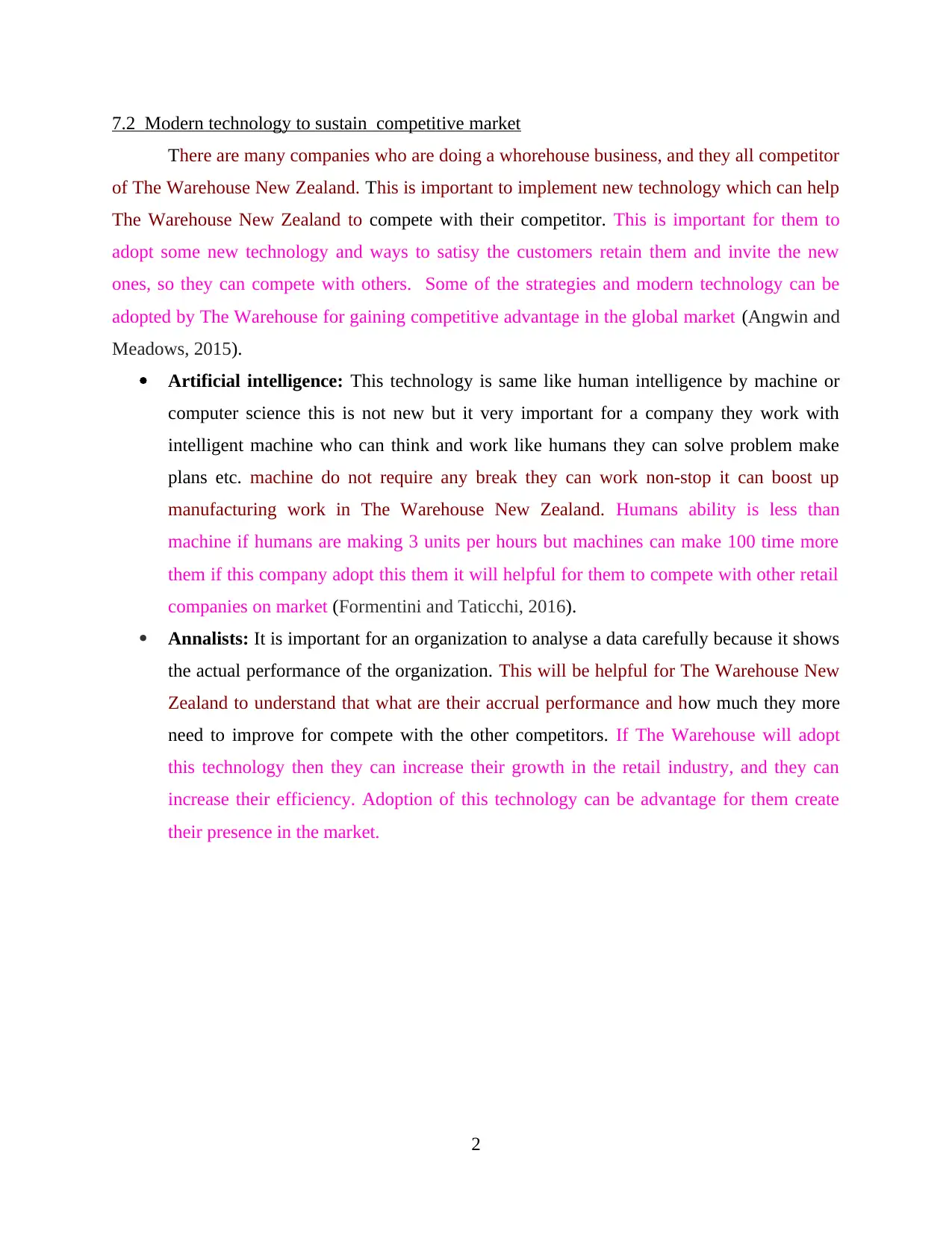
7.2 Modern technology to sustain competitive market
There are many companies who are doing a whorehouse business, and they all competitor
of The Warehouse New Zealand. This is important to implement new technology which can help
The Warehouse New Zealand to compete with their competitor. This is important for them to
adopt some new technology and ways to satisy the customers retain them and invite the new
ones, so they can compete with others. Some of the strategies and modern technology can be
adopted by The Warehouse for gaining competitive advantage in the global market (Angwin and
Meadows, 2015).
Artificial intelligence: This technology is same like human intelligence by machine or
computer science this is not new but it very important for a company they work with
intelligent machine who can think and work like humans they can solve problem make
plans etc. machine do not require any break they can work non-stop it can boost up
manufacturing work in The Warehouse New Zealand. Humans ability is less than
machine if humans are making 3 units per hours but machines can make 100 time more
them if this company adopt this them it will helpful for them to compete with other retail
companies on market (Formentini and Taticchi, 2016).
Annalists: It is important for an organization to analyse a data carefully because it shows
the actual performance of the organization. This will be helpful for The Warehouse New
Zealand to understand that what are their accrual performance and how much they more
need to improve for compete with the other competitors. If The Warehouse will adopt
this technology then they can increase their growth in the retail industry, and they can
increase their efficiency. Adoption of this technology can be advantage for them create
their presence in the market.
2
There are many companies who are doing a whorehouse business, and they all competitor
of The Warehouse New Zealand. This is important to implement new technology which can help
The Warehouse New Zealand to compete with their competitor. This is important for them to
adopt some new technology and ways to satisy the customers retain them and invite the new
ones, so they can compete with others. Some of the strategies and modern technology can be
adopted by The Warehouse for gaining competitive advantage in the global market (Angwin and
Meadows, 2015).
Artificial intelligence: This technology is same like human intelligence by machine or
computer science this is not new but it very important for a company they work with
intelligent machine who can think and work like humans they can solve problem make
plans etc. machine do not require any break they can work non-stop it can boost up
manufacturing work in The Warehouse New Zealand. Humans ability is less than
machine if humans are making 3 units per hours but machines can make 100 time more
them if this company adopt this them it will helpful for them to compete with other retail
companies on market (Formentini and Taticchi, 2016).
Annalists: It is important for an organization to analyse a data carefully because it shows
the actual performance of the organization. This will be helpful for The Warehouse New
Zealand to understand that what are their accrual performance and how much they more
need to improve for compete with the other competitors. If The Warehouse will adopt
this technology then they can increase their growth in the retail industry, and they can
increase their efficiency. Adoption of this technology can be advantage for them create
their presence in the market.
2
⊘ This is a preview!⊘
Do you want full access?
Subscribe today to unlock all pages.

Trusted by 1+ million students worldwide
1 out of 16
Related Documents
Your All-in-One AI-Powered Toolkit for Academic Success.
+13062052269
info@desklib.com
Available 24*7 on WhatsApp / Email
![[object Object]](/_next/static/media/star-bottom.7253800d.svg)
Unlock your academic potential
Copyright © 2020–2025 A2Z Services. All Rights Reserved. Developed and managed by ZUCOL.




